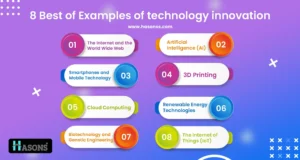What is Technology Innovation?
Technological innovation is the development of new or enhanced technologies, equipment, methods, procedures, and designs that result in improvements or enhancements in one or more fields of use. They provide solutions to some issues, increase productivity, fuel economic development, and make people’s lives better. Technology innovation relies on scientific knowledge, professionalism, and resources to create sophisticated solutions that serve current demands and lay down the foundations for further evolution.
The role of technology innovation is indeed complex, as discussed above. It stimulates economic growth, promotes competition, and creates new prospects for development. Furthermore, it has a major contribution to the resolution of existing world issues including climate change, healthcare, and development. With technological advancement being a growing trend in the current generation, it is paramount to embrace change.
8 Best Examples of Technology Innovation

1. The Internet and the World Wide Web
The discovery of the Internet and the World Wide Web changed the way we exchange messages, transfer knowledge, and engage in commerce. It provided the groundwork for e-commerce, social networks, online learning, and beyond, impacting almost every sector in today’s world.
2. Smartphones and Mobile Technology
Communication technology is also advanced and currently, everyone has a smartphone which can be considered as a portable computer. Mobile technology developments have provided an opportunity for communication, navigation, and multimedia use as well as access to a multitude of applications to boost users’ productivity and entertainment.
3. Cloud Computing
Cloud computing has completely changed the way companies manage their operations, as offers networking applications that can switch from local to cloud resources on an as-needed basis. This makes it possible for organizations to minimize cost, increase efficiency, and not worry about managing other complicated IT frameworks.
4. Artificial Intelligence (AI)
Artificial Intelligence (AI) is one of the technological drivers of the present and the future, promising improvements in such areas as machine learning, robotics, and natural language processing. Virtual Assistants of Apple’s Siri and Amazon’s Alexa, Self-Driving Cars, and Smart Diagnostic Systems are a few examples that AI is revolutionizing industries and recreating our competencies.
5. 3D Printing
The concept of 3D printing or additive manufacturing has changed the way of manufacturing as it has brought customization to manufacture components for a diverse range of applications. This technology is in use today especially in healthcare, aerospace, and automotive industries, due to the benefits it has to offer like the cost and design benefit.
6. Renewable Energy Technologies
Renewable energy such as solar energy, wind energy, and energy storage technology are essential to move away from fossil energy and fight climate change. These innovations have brought clean energy closer and made it cheaper, smarter, and efficient enough to spur the energy transformation required for sustainability.
7. Biotechnology and Genetic Engineering
Thus, the successful development of biotechnology and genetic engineering has boosted the progress of medicine, agriculture, and the conservation of the environment. Technologies like CRISPR-Cas9 genome editing and individualized medicine are disrupting health care and coming up with solutions to global issues.
8. The Internet of Things (IoT)
In the IoT, objects become part of the internet and are capable of gathering information. This technology is slowly revolutionizing industries ranging from homes through allowing smart homes, manufacturing through enhancing production and operations, and even health and fitness through wearable technology such as smart wristbands, and smartwatches.
Top 10 Best Practices for Strategic Management of Technology Innovation
1. Align Innovation with Business Strategy
Make sure your technology innovation is relevant and has a link with your organization’s strategic direction. These technology development goals must align with organizational business goals, such as generating more sales improving customer experiences, or moving into a new market.
2. Foster Cross-Functional Collaboration
Enhance cross-unit working in your organization. This means that there will be better solutions provided and everyone’s input will increase the chances of success for the technology projects.
3. Cultivate a Culture of Innovation
Ensure that the organization positively attitudes innovation and comes up with policies that support this factor. Allow the workers to report, explore, and learn from sharing their ideas to improve the organization. Openness to change coupled with the ability of people to take risks is critical for the growth of technology.
4. Set Clear Innovation Objectives
Set clear objectives that are quantifiable for the technological development projects. It is when clear objectives have been created that the achievement of the goals set, the progress made, and the effectiveness of the work done can be measured.
5. Embrace Open Innovation
Seek external sources of innovation to tap into sources of not only new ideas but also resources and knowledge. Common, open innovation can work for the enhancement of development of your initiatives, and creativity, as well as raise the likelihood of success of your technology-related projects.
6. Invest in Research and Development (R&D)
Invest some of your resources in Web research and development so that Web-based technologies can be continuously studied and pilot new solutions. The key issue to be addressed here is that a firm needs to have a strong R&D department as that offers the ability to fend off competitors in the long term.
7. Continuously Monitor Technological Trends
The growing factors that should be monitored are new technologies and market characteristics. The only way to ensure you are safe and set to conquer the market is by scanning through the technological horizon from time to time.
8. Manage Risks and Protect Intellectual Property (IP)
Assess potential risks that may be relevant to your technology innovation projects including; technical risks, legal risks, and potential competition risks. Take legal steps such as through patents, trademarks, etc. to protect the intellectual property that you have developed.
9. Measure and Evaluate Innovation Impact
Introduce criteria to measure the outcomes of the technological innovations you are to introduce. Periodically evaluate results and collect feedback which can all be analyzed to come up with better strategies and future prospects.
10. Adopt an Agile and Iterative Approach
Ensure the use of issued-based processes in directing the development of technology innovation projects. In dividing large-scale projects into workable components, you can respond to changing conditions, experiment & refine your strategies based on user engagement.
Conclusion
Technology advancement as we have seen is a force that can enhance growth, enhance the wellbeing of people, and determine what is to happen in the future. This paper explains that when organizations pay attention to innovation, properly implement promotion procedures, accommodate them, and manage them for organizational development, it will benefit the organization and the global community and we will create a prosperous world.
| If you are reading Technology Innovation then also check our other blogs | |
| Computer Virus | First Electronic Computer |
| COPA Full Form | Pros of technology |
Technology Innovation

